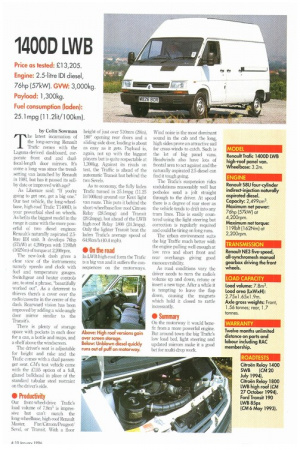1400D MB
Page 27

If you've noticed an error in this article please click here to report it so we can fix it.
by Colin Sowman
The latest incarnation of the long-serving Renault Trafic comes with the Laguna-derived dashboard, corporate front end and dualfocal-length door mirrors. It's come a long was since the trendsetting van launched by Renault in 1981, but has it passed its sellby date or improved with age?
As Liberace said: "If you're going to get one, get a big one." Our test vehicle, the long-wheelbase, high-roof Trafic 114001), is your proverbial shed on wheels. As befits the biggest model in the range it came with the more powerful of two diesel engines: Renault's naturally aspirated 2.5litre HA unit. It develops 76hp (57kW) at 4,200rpm with 1191bft (162Nm) of torque at 2,200rpm.
The new-look dash gives a clear view of the instruments; namely speedo and clock with fuel and temperature gauges. Switchgear and heater controls are, to steal a phrase, "beautifully worked out". As a deterrent to thieves there's a cover over the radio/cassette in the centre of the dash. Rearward vision has been improved by adding a wide-angle door mirror similar to the Transit's.
There is plenty of storage space with pockets in each door for a can, a bottle and maps, and a shelf above the windscreen.
The driver's seat is adjustable for height and rake and the Trafic comes with a dual passenger seat. CM's test vehicle came with the £155 option of a full, glazed bulkhead in place of the standard tubular steel restraint on the driver's side.
• Productivity
Our front-wheel-drive Trafic's load volume of 7.8m3 is impressive but can't match the long-wheelbase, high-roof Renault
Master, Fiat/Citroen/Peugeot/ Sevel, or Transit. With a floor height of just over 510mm (20in), 180° opening rear doors and a sliding side door, loading is about as easy as it gets. Payload is, again, not up with the biggest players but is quite respectable at 1,300kg. Against its rivals on test, the Traffic is ahead of the automatic Transit but behind the two Sevels.
As to economy, the fully laden Trafic turned in 25.1mpg (11.25 lit/100km) around our Kent light van route. This puts it behind the short-wheelbase/low roof Citroen Relay (28.5mpg) and Transit (29.2mpg), but ahead of the LWB high-roof Relay 1800 (24.3mpg). Only the lighter Transit beat the laden Trafic's average speed of 64.9km/h (40.4 mph).
• On the road
In DNB high-roof form the Trafic is a big van and it suffers the consequences on the motorways. Wind noise is the most dominant sound in the cab and the long, high sides prove an attractive sail for cross-winds to catch. Such is the lot of big panel vans. Headwinds also have lots of frontal area to act against and the naturally aspirated 2.5 diesel can find it tough going.
The Trafic's suspension rides undulations reasonably well but potholes send a jolt straight through to the driver. At speed there is a degree of rear steer as the vehicle tends to drift into any tram lines. This is easily countered using the light steering but correction is regularly required and could be tiring on long runs.
The urban environment suits the big Traffic much better with the engine pulling well enough at low revs and short front and rear overhangs giving good manoeuvrability.
As road conditions vary the driver needs to turn the radio's volume up and down, retune or insert a new tape. After a while it is tempting to leave the flap down, causing the magnets which hold it closed to rattle incessantly.
• &Mar)!
On the motorway it would benefit from a more powerful engine. But around town the big Trafic's low load bed, light steering and updated mirrors make it a good bet for multi-drop work.




















































































